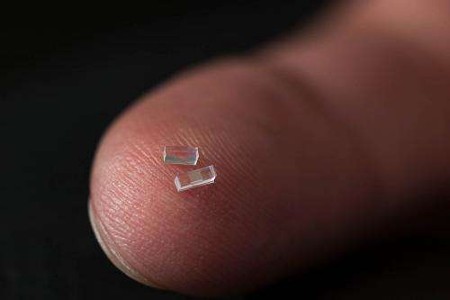April 26, 2020 – A team of researchers back in January of this year reported they had created a particle accelerator that could fit on a tiny computer chip. Now I don’t know about you, but when I think of particle accelerators, the Large Hadron Collider (CERN) comes to mind. The CERN is 27 kilometers (nearly 16.8 miles) in length, aring-shaped oval buried under the Alps. It discovered the Higgs Boson Particle in 2013 confirming one of the key theories about how the Universe works.
So how can you suddenly have one powered by a chip that is so tiny that hundreds could fit on a fingertip (see image below) and that can be incorporated into a different applications and uses in form factors no bigger than a shoebox?
The lead author of the research done at Stanford University, Neil Sapra, describes particle accelerators as much more than technology designed to unlock the mysteries of the Universe. He states, “Particle accelerators are commonly used for medical (cancer treatments, imaging techniques) and industrial (ion implantation, sterilization, imaging) applications, but compact accelerators for these applications still take up entire rooms or the backs of semi-trucks. Part of the reason for this is that they are based on radio-frequency waves, which have a long wavelength.”
The particle accelerators he is talking about come in a variety of sizes. The technology has helped to make magnetic resonance imaging (MRI) possible. Particle accelerators have been fundamental to the development of nuclear power stations. Particle accelerators underly the x-ray technology used to boost security in airports. They are useful technologies for radiotherapy and x-ray devices. They are used to breakdown wastewater and smokestack gases to remove contaminants. They help physicists identify new materials, biologists discover new viruses and proteins, and pharmacologists develop new drugs and vaccines. They are even used to create shrink-wrapped packaging.
The Stanford invention is a dielectric laser accelerator (DLA) that uses smaller wavelengths than the CERN. This allows for a significant size reduction by a factor of 10,000. What gets lost in reducing the particle accelerator’s size is velocity. Big accelerators can ramp up to near light speed as they endeavour to smash atoms into subatomic components. But those kinds of speeds aren’t needed for industrial applications. States Sapra, “The ultimate goal … is to achieve an accelerator capable of producing 1 MeV [one megavolt] energy beams which can be a truly compact (imagine shoe-box size or even smaller) particle accelerator for medical, industrial, and scientific applications that can be widely and cheaply available.”
In the future small particle accelerators like the DLA could become a common household technology. Is this farfetched?
The discoverer of microwaves back in 1864, James Maxwell, (made famous for his equations), would never have contemplated its use in cooking. And yet today, there are very few homes without microwave ovens. In fact, some homes today no longer come with conventional ovens.
So Imagine a DLA in the future being used to enhance communications, broadcasting, and in a more distant future teleportation or even time travel. Star Trek, here we come.









